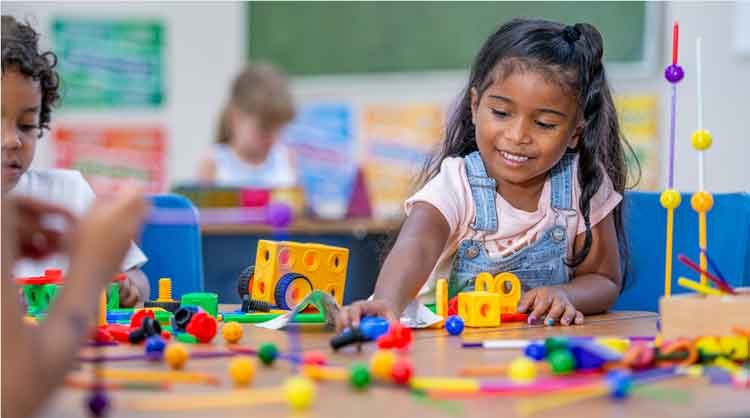The Montessori approach is celebrated for its child-centered learning, but ensuring that Montessori classrooms are truly inclusive requires thoughtful adaptations to meet the needs of diverse learners. This article explores how inclusive adaptations in the Montessori apparatus can foster an environment that supports all children, regardless of their abilities or backgrounds.
The Importance of Inclusion in Montessori Education
Inclusion is essential in creating a learning environment where every child feels valued and supported. Diverse classrooms may include children with physical, cognitive, sensory, or socio-emotional needs. By adapting traditional Montessori apparatus and methods, educators can uphold Dr. Maria Montessori’s vision of fostering independence while ensuring that all students can engage meaningfully in their learning journeys.
Key Inclusive Adaptations in Montessori Apparatus
1. Multi-Sensory Materials Adapting Montessori materials to engage multiple senses can help children with varying learning preferences and sensory needs. For example, sandpaper letters can be modified with different textures or scents to enhance sensory experiences. Providing materials that stimulate touch, sight, and sound helps create a more inclusive environment where children with sensory processing challenges can thrive.
2. Adjustable Tools for Physical Accessibility For children with physical disabilities, apparatus like the pink tower or knobbed cylinders can be adjusted to be lighter or come with adaptive grips. Furniture can be modified to be height-adjustable, and workspaces can be rearranged to accommodate wheelchairs or other mobility aids. Ensuring that physical adaptations are part of the classroom design allows children with limited mobility to engage independently with Montessori materials.
3. Visual and Auditory Supports Including visual and auditory aids in the classroom can support children who are deaf or hard of hearing, as well as those with visual impairments. For instance, flashcards with large print or braille can accompany standard Montessori reading materials. Auditory cues, such as gentle chimes or recordings, can signal transitions or provide instructions for those with visual challenges.
4. Simplified and Step-by-Step Instructions Children with cognitive or learning disabilities may benefit from simplified, step-by-step guides for using Montessori materials. These guides can include visual instructions or pictures that break down complex tasks into manageable steps. Providing explicit teaching moments and demonstrating tasks multiple times can also support these learners in mastering new activities.
5. Inclusive Language and Culturally Relevant Content Ensuring that classroom content reflects diverse cultures and languages promotes inclusivity for children from various backgrounds. Storybooks, maps, and language materials should represent different cultures and perspectives to make all students feel seen and valued. Bilingual or multilingual materials can also help non-native speakers engage more confidently with the curriculum.
Strategies for Implementing Inclusive Adaptations
1. Collaborate with Specialists Partnering with special education experts, occupational therapists, or speech pathologists can provide valuable insights into how to modify Montessori materials effectively. These specialists can guide educators on the best practices for creating adaptive materials and using assistive technologies.
2. Observe and Adapt Based on Student Needs One of the key tenets of Montessori education is observation. Educators should observe how children interact with various materials and identify any barriers they face. Adaptations can then be tailored to meet individual needs, ensuring that all children can participate actively in learning.
3. Foster a Peer-Supportive Environment Creating an atmosphere where children are encouraged to help and learn from one another fosters a sense of community and empathy. Group activities that pair students with varying strengths can promote collaboration and mutual understanding, enhancing the social-emotional learning (SEL) aspect of Montessori education.
4. Train Educators on Inclusive Practices Teachers should receive training on how to implement inclusive adaptations in the classroom effectively. Professional development workshops focused on inclusivity and adaptive teaching techniques can empower educators to create a more equitable learning space.
Benefits of Inclusive Adaptations
1. Enhanced Engagement and Participation Inclusive adaptations ensure that all children can access the curriculum and participate fully, leading to greater engagement. When children see themselves represented and supported, they are more motivated and invested in their learning.
2. Development of Empathy and Social Skills Inclusive classrooms teach all students the value of empathy and acceptance. Children learn to understand and appreciate differences, fostering a sense of community and belonging that benefits everyone.
3. Promotion of Independence and Confidence When adaptations are thoughtfully integrated, they enable children with special needs to complete tasks independently. This independence builds confidence and encourages a positive attitude toward learning.
Incorporating inclusive adaptations into the Montessori apparatus helps create a learning environment that respects and celebrates diversity. By making materials accessible and providing supportive strategies, educators can ensure that every child, regardless of their abilities, has the opportunity to thrive. Through ongoing observation, collaboration with specialists, and commitment to training, Montessori classrooms can embody true inclusivity that aligns with Dr. Maria Montessori’s vision.
Content Prepared by: Pratheek
Contact no : +91 98468 08283




